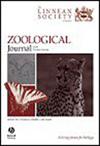Temporal and spatial variation of sexual size and shape dimorphism of Cyprideis torosa (Ostracoda)
IF 2.8
2区 生物学
Q1 ZOOLOGY
引用次数: 0
Abstract
Sexual differences in the size and shape of males and females are widespread in the animal kingdom, but research on sexual dimorphism in ostracods has been limited. From 718 individual ostracod valves of the species Cyprideis torosa, we extracted size (length and height) and valve width (from focus-stacked photographs), and we used geometric morphometrics to analyse the shape of valve outlines. Variability of C. torosa was investigated on different geographical (Baltic Sea, Central Germany, and Mediterranean area) and geological (Holocene to living) scales. We found that sexual differences were greater in shape than in size and that populations on our geographical scale showed a differentiation in size. Dimorphism in width was investigated in detail for the first time for ostracods and showed strongest dimorphism within the size traits. The examination of the relationship between size and shape revealed sex-specific, regional, and temporal patterns. All size traits of C. torosa showed allometry consistent with Rensch’s rule. Isolation of the Mansfeld Lakes populations from marginal marine environments might have contributed to morphological differentiation as expression of possible speciation. We suggest that morphological variability in C. torosa results from a combination of sex-specific and scale-dependent geographical phenotypic plasticity and regional sexual and fecundity selection pressures on the sexes.介形目扁扁螺性别大小和形状二态性的时空变化
雄性和雌性在大小和形状上的性别差异在动物界普遍存在,但对介形虫性别二态性的研究却很有限。从718个壳状动物瓣中提取了大小(长度和高度)和瓣宽(从焦点叠加照片中),并使用几何形态计量学分析了瓣的轮廓形状。研究了不同地理尺度(波罗的海、德国中部和地中海地区)和不同地质尺度(全新世到现生)上红毛藻的变异。我们发现性别差异在形状上比在大小上更大,在我们的地理范围内,人口在大小上表现出差异。本文首次对介形虫的宽度二态性进行了详细的研究,并在大小性状中表现出最强的二态性。对大小和形状之间关系的研究揭示了性别、区域和时间模式。各大小性状均表现异速生长,符合Rensch规则。从边缘海洋环境中分离出来的曼斯菲尔德湖种群可能有助于形态分化,作为可能的物种形成的表达。我们认为,金盏花的形态变异是性别特异性和尺度依赖性地理表型可塑性以及性别的区域性性和繁殖力选择压力的综合结果。
本文章由计算机程序翻译,如有差异,请以英文原文为准。
求助全文
约1分钟内获得全文
求助全文
来源期刊
CiteScore
6.50
自引率
10.70%
发文量
116
审稿时长
6-12 weeks
期刊介绍:
The Zoological Journal of the Linnean Society publishes papers on systematic and evolutionary zoology and comparative, functional and other studies where relevant to these areas. Studies of extinct as well as living animals are included. Reviews are also published; these may be invited by the Editorial Board, but uninvited reviews may also be considered. The Zoological Journal also has a wide circulation amongst zoologists and although narrowly specialized papers are not excluded, potential authors should bear that readership in mind.

 求助内容:
求助内容: 应助结果提醒方式:
应助结果提醒方式:


